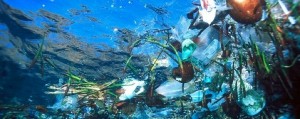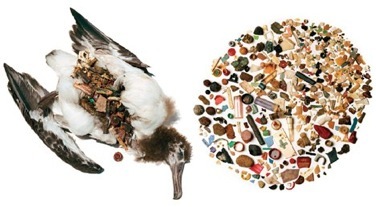- Plastic is a term which describes a variety of man-made molecules composed of repeating structural units. These large molecules are called polymers, and each repeating unit within a polymer is called a monomer.
- The monomers comprising plastic polymers are usually derived from petroleum, also known as crude oil.
- Petroleum is a fossil fuel found deep beneath the Earth’s surface. The fossil fuels we use today are formed from plants and animals that lived millions of years ago. Their decaying remains were covered by sand and silt layers. The heat and pressure created by the layers turned the organic remains into oil and gas.
- Plastic manufacturing can be compared to making a daisy chain. Like the flowers linked together to create a daisy chain, monomers are joined together with chemical bonds to create a polymer.
- There are many types of plastic. The appearance and properties of a plastic depend on the specific patterns of monomers and the length of the polymer chain.
- Plastics can be hard, soft, flexible, rigid, rubbery, light, or heavy.
- The variation among plastics makes them useful for many purposes. Plastics are found in cars, computers, packaging, homes, and hospitals.
- Common examples of plastics include Styrofoam, nylon, PVC, Teflon, and polyester.
- Although plastics are very useful in everyday life, they can have negative health and environmental effects.
- Some monomers used in manufacturing plastic are known carcinogens, or substances that cause cancer.
- Bisphenol A, or BPA, is a chemical commonly found in plastic water bottles. When consumed by humans, it disrupts the endocrine system, which is responsible for regulating hormones throughout the body. Long-term consumption of BPA can lead to complications in brain and body development.
- Although it is possible to recycle most types of plastic, it is estimated that only about 25% of plastics are recycled worldwide. The remaining plastic ends up as litter or in landfills.
- Plastics are not easily broken down by decomposers (organisms that consume dead or decaying matter) or naturally occurring enzymes (substances that speed up chemical reactions). As a result, pastic decomposes very slowly.
- Different types of plastic decompose at different rates. A plastic bag exposed to direct sunlight may decompose in 50 years, while most plastic containers require 500-1000 years to break down completely.
- Huge quantities of plastic end up in the ocean, where currents (the steady flow of water in a specific direction) cause it to aggregate in high concentrations in certain locations.
- The North Pacific Gyre is an ocean current within which an enormous mass of plastic trash has accumulated. This specific accumulation of trash is known as the Pacific Trash Vortex, or PTV. Near the PTV, scientists found six times more plastic than plankton (small or microscopic organisms that that float in the water in large numbers, forming the base of the marine food chain).
- Recent research indicates that every major ocean basin has areas where trash is accumulating in large quantities.
- Scientists sampled ocean water from all over the world, and every single water sample contained plastic – it’s everywhere!
- Over time, plastic in the ocean decomposes, breaking down into small particles called nurdles. Nurdles closely resemble organisms like jellyfish and zooplankton, which are food sources for sea turtles, seabirds, marine mammals, fishes, and many other marine organisms.
- When marine animals die for unknown reasons, scientists often conduct necropsies, or after-death examinations, to identify the cause of death.
- Necropsies of marine animals have revealed stomachs full of plastic trash resembling commonly consumed food items. When animals consume plastic, they are unable to digest it. The plastic remains in an organism’s stomach and prevents the animal from digesting natural food sources, starving it of necessary nutrients until it can no longer survive.
- As plastic breaks down in the water, it releases toxic chemicals, which are absorbed through the skin and gills of marine organisms and may cause harmful physiological effects over long periods of time.
Practice Good Stewardship
- Pick up plastic litter. If you see plastic or other trash on the ground, collect it and dispose of it properly. Recycle whenever possible.
- Ask for a reusable water bottle, and drink from it instead of single-use disposable water bottles.
- Instead of using to-go boxes, bring Tupperware for your leftovers when you eat at a restaurant.
- Consume less plastic by bringing your own reusable bags to the store.
Did you know?
The top ten categories of debris in the ocean:
1. Cigarette butts 2. Plastic bags 3. Food containers 4. Caps and lids 5. Plastic bottles
6. Paper bags 7. Straws and stirrers 8. Cups, plates, eating utensils 9. Glass bottles
10. Beverage cans
Podcast: Synthetic Seas
Review Questions
- Define plastic and describe its structure. Why does plastic take many years to decompose?
- What are three uses of plastic in our everyday lives?
- List one negative effect of plastic on the environment.
- What it the Pacific Trash Vortex? In which ocean current is it located?
- What are two things you can do to help reduce the amount of plastic that ends up in the ocean?
Glossary
Carcinogen: Any substance that is known to cause cancer
Crude Oil: A mixture of naturally occurring hydrocarbons that is found deep underground and is generated naturally from decaying plant and animal matter over millions of years; crude oil is refined into products like diesel, gasoline, and plastics
Current: The steady flow of water in a specific direction
Decomposer: An organism that consumes dead or decaying matter
Endocrine System: A system of glands throughout the body, each of which discharges a type of hormone into the bloodstream to regulate body functions
Enzyme: A substance that speeds up a reaction
Fossil Fuel: Fuel consisting of the remains of organisms preserved in rocks beneath the Earth’s surface over millions of years; includes petroleum, coal, and natural gas.
Monomer: One unit in a polymer
Necropsy: A medical examination that takes place after the death of a non-human organism
North Pacific Gyre: A Pacific ocean current that has attracted large amounts of trash
Nurdles: Plastic pieces under 5 mm in diameter that often resemble zooplankton and other common sources of food for marine species
Pacific Trash Vortex: The accumulation of trash in the North Pacific Gyre
Petroleum: see crude oil
Physiological: Relating to the body
Plankton: Small organisms that float or drift in large numbers in both fresh and saltwater
Plastic: A common term used to describe man-made polymers
Polymer: Large molecules composed of repeating structural units (made up of carbon and other elements); each unit in a polymer is called a monomer
Recycle: To treat or process used or waste materials so that they can be used again







